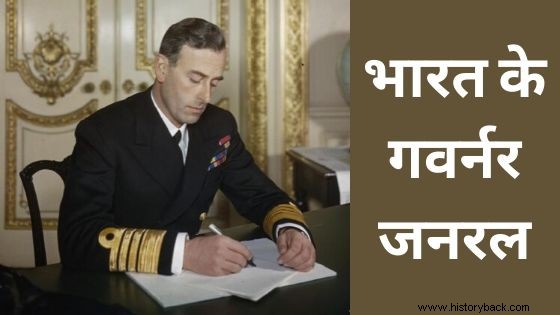Today in this article we will tell you India History in Hindi – Governor General of India Telling about.
Railways Group D Bharti Practice Set 2020
Governor General of India

Lord William Bentinck (1828- 1835 AD)
Q. Who was the first Governor General of India?
Ans. Lord William Bentinck
Q. Who abolished the practice of Sati?
Ans. In 1829, with the help of Raja Rammohun Roy, Bentinck
Q. Apart from Bentinck, who had tried to stop the practice of Sati?
Ans. Akbar and Maratha Peshwas
Q. Who put an end to the thugs?
Ans. In 1830, with the help of Colonel Smilan, Bentinck
Q. Who established the Calcutta Medical College in Calcutta?
Ans. Bentinck in 1835 AD
Q. Who made English the medium of instruction?
Ans. Bentinck on the recommendation of Macaulay
Q. By whom was the law classified?
Ans. by Macaulay
Q. When did Bentinck take over Mysore?
Ans. In 1831 AD
Q. When did Bentinck usurped Coorg and Madhyacher?
Ans. In 1834 AD
Q. Who banned the killing of infant girl?
Ans. Bentinck
Lord Charles Metcalf (1835-36 AD)
Q. Who is called the liberator of the Indian press?
Ans. Charles Metcalf
Lord Auckland (1836- 42 AD)
Q. Who took the repair of Grand Trunk Road from Calcutta to Delhi?
Ans. Lord Auckland in 1839 AD
Q. In whose time did the First Anglo-Afghan War (1839-42 AD) take place?
Ans. Auckland's
Lord Ellenborough (1842- 44 AD)
Q. When did the First Anglo-Afghan War end?
Ans. Lord Ellenborough's
Q. When was Sindh completely annexed to the British Empire?
Ans. In 1843 AD
Q. In whose time slavery was abolished?
Ans. Ellenborough's
Lord Hardinge (1844- 48 AD)
Q. The First Anglo-Sikh War (1845-46 AD) was fought during?
Ans. Harding's
Q. Who was victorious in the Anglo-Sikh war?
Ans. of the British
Q. Who banned the practice of Narbali?
Ans. Harding
Lord Dalhousie (1848- 56 AD)
Q. In whose time did the Second Anglo-Sikh War and the merger of Punjab with the British rule take place?
Ans. Dalhousie's
Q. In what time did the Second Anglo-Burma War take place?
Ans. Dalhousie's
Q. When were Lower Burma and Pigu annexed to the British Empire?
Ans. Dalhousie in 1852 AD
Q. When did Dalhousie take over Sikkim?
Ans. In 1850 AD
Q. Who established the Inam Commission?
Ans. Dalhousie in 1852 AD
Q. By whom was the 'State Grab Policy' implemented?
Ans. Dalhousie's
Q. Which Indian states were annexed under the 'State usurp policy' (Doctrine of Lapse)?
Ans. Jhansi, Nagpur, Satara, Jaipur, Avadh and Sambalpur
Q. Who was the Nawab of Awadh at the time of Dalhousie?
Ans. Wajid Ali Shah
Q. Where did Dalhousie move the artillery headquarters from Calcutta?
Ans. In Meerut in 1856 AD
Q. Where did Dalhousie set up the army headquarters?
Ans. In Shimla
Q. Who implemented Wood Dispatch?
Ans. Dalhousie in 1854 AD
Q. What was Wood Dispatch related to?
Ans. From Education Reforms
Q. Who is considered the father of railways in India?
Ans. Between Bombay to Thane in 1853 AD (34 km)
Q. Who passed the new Post Office Act?
Ans. Dalhousie in 1854 AD
Q. In which time did the circulation of postage stamps started in India for the first time?
Ans. Dalhousie's
Q. Who established the Public Works Department?
Ans. Dalhousie
Q. Who established the Public Service Department?
Ans. Dalhousie
Q. When was the first electric wire service between Calcutta and Agra started?
Ans. In 1853 AD
Q. Dalhousie made the summer capital of whom?
Ans. To Shimla
Q. Who started the first competitive examination for the Indian Civil Services?
Ans. Dalhousie
Today in this article we have given you India History in Hindi – Governor General of India, Governor General and Viceroy of India, Who is the Governor of India, Governor General of India 2020, Chief Governor General If you want any other information related to this, then you can ask by commenting in the comment box.
